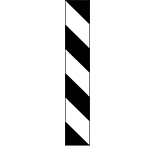When to use headlights
You must turn on your vehicle’s headlights:
- from 30 minutes after sunset until 30 minutes before sunrise
- at any other time when you can’t clearly see a person or vehicle 100 metres away.
Never drive with just the park lights on.
Note: park lights are also known as position lamps.
When to dip your vehicle’s headlights
You must dip your vehicle’s headlights:
- when other vehicles are coming towards you, so that you don’t blind the oncoming driver
- when following other vehicles
- when approaching a police officer who's directing traffic
- when parked.

Dipping headlights for an oncoming vehicle

If there's plenty of street lighting, you should be able to drive with your headlights dipped the whole time.
Important!
Be aware that at night, because most road signs are highly reflective, your lights shining on them may make you think you can see further than you really can. Make sure you drive more slowly and carefully at night, particularly on unfamiliar roads.
|
Speed at night
You must drive at a safe speed at night. This means that:
- on a road with lanes, you must be able to stop in the length of clear road you can see in front of you
- on a road with no lanes, you must be able to stop in half the length of clear road you can see in front of you.
Safety tips for night driving
Driving at night is more dangerous than driving during the day. To improve your safety on the road at night:
- make sure your windscreen and lights are clean
- never wear dark glasses
- watch for pedestrians and cyclists – they're harder to see at night
- stop and rest if you're sleepy
- don’t blind other drivers with your vehicle’s headlights – dip them when vehicles are coming towards you or when you're following another vehicle
- if you're blinded by the lights of oncoming vehicles:
- slow down or stop
- try to keep your eyes on the left side of the road, so you’re not looking directly at the light
- drive at a speed that means you can see the road at least 2 seconds ahead
- in an area without street lighting, use full beam as appropriate to increase how far you can see.
Use markers to guide you when driving at night
Many roads have reflectors and guide posts to help you read the road at night. Some examples of these are shown below.

Left side of the road marker post

Right side of the road marker post indicating left-hand bend

Left side of bridge

Right side of bridge

Left side of road

Centre line

No passing

Fire hydrant









